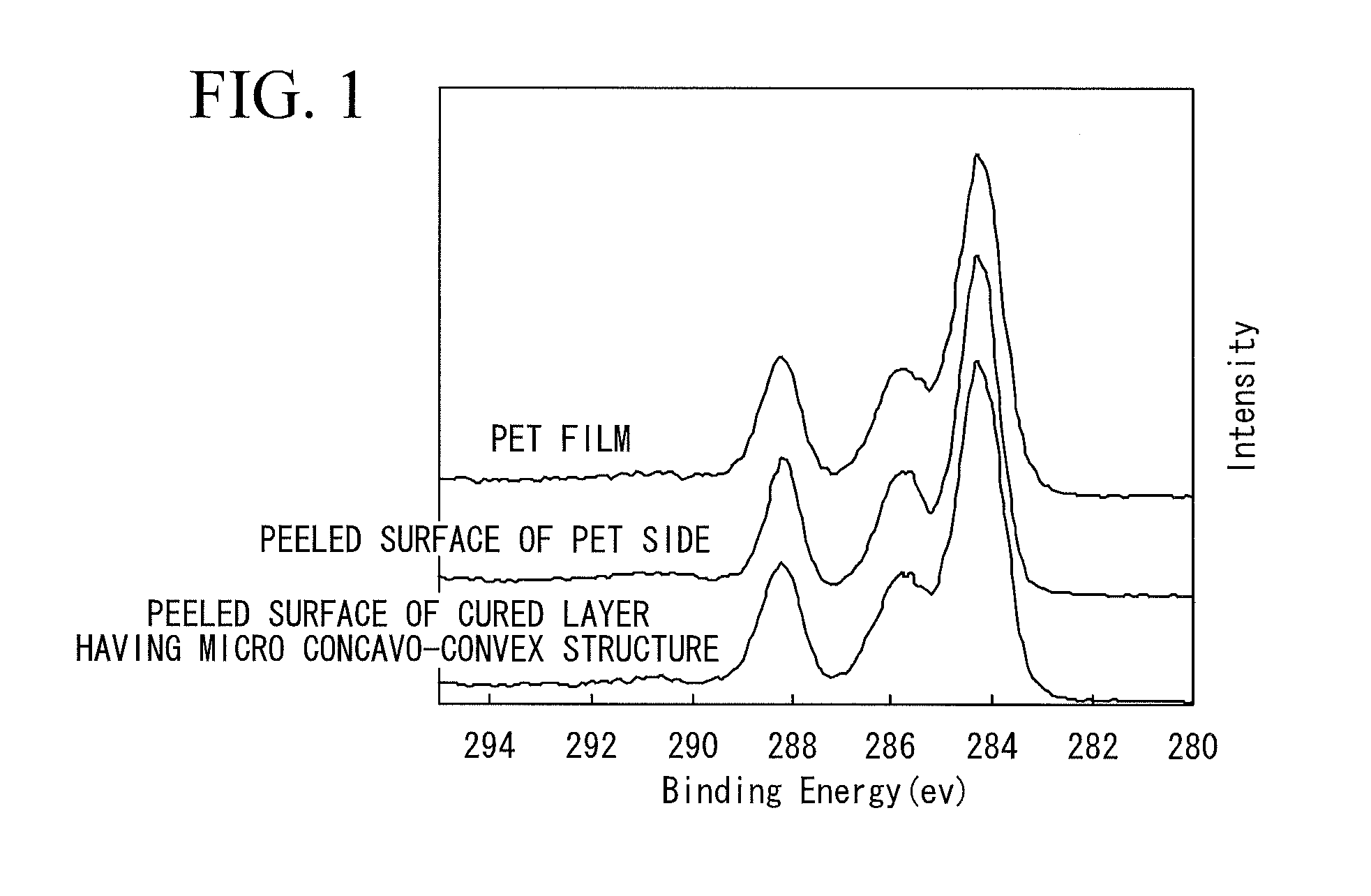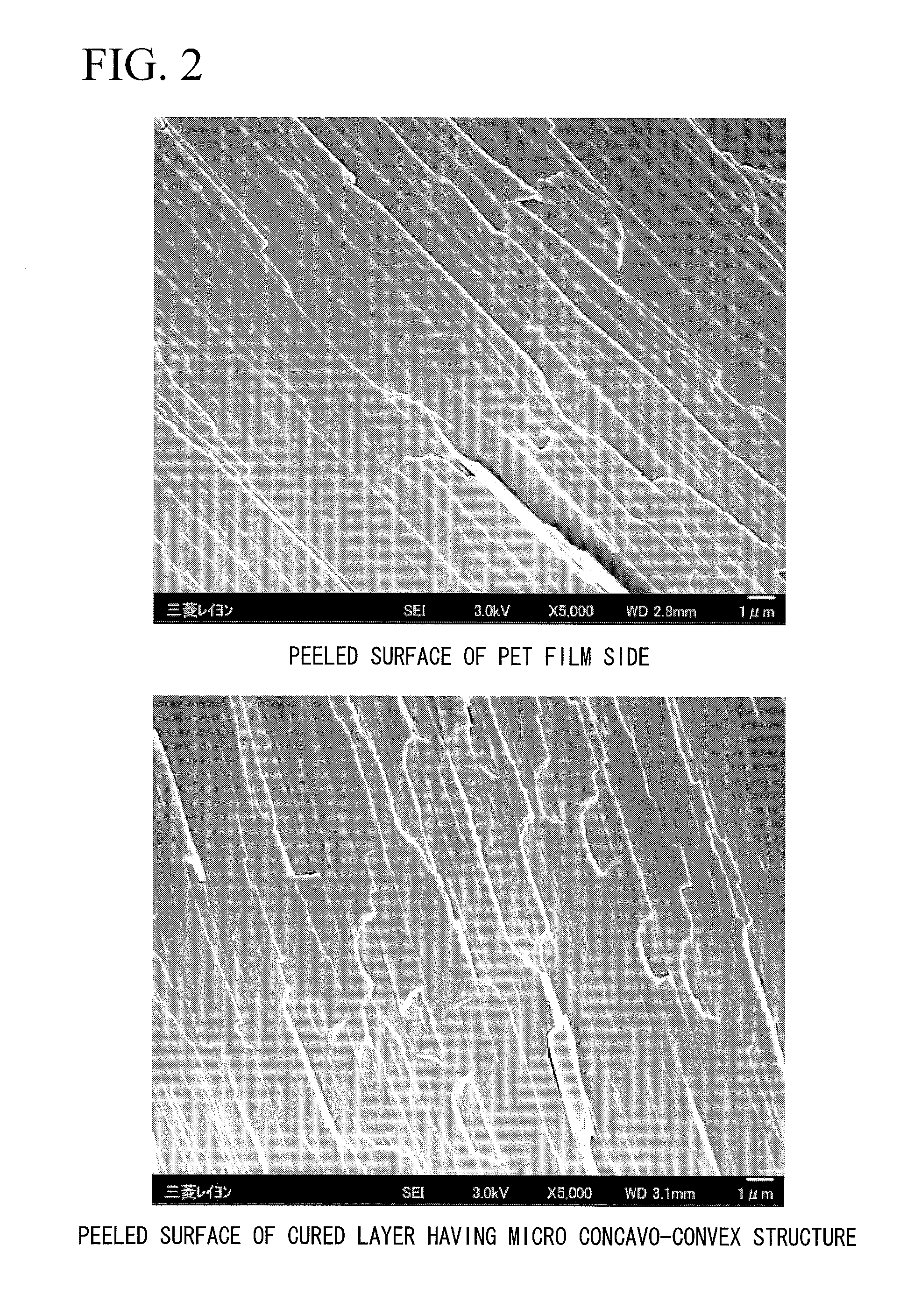Process for producing film
a technology of transparent film which is applied in the direction of synthetic resin layered products, instruments, transportation and packaging, etc., can solve the problems of organic mold release agent on the mold surface markedly deteriorating and degrading, transparent film having a micro protrusion and recess face structure on the surface thereof cannot be stably prepared, etc., to achieve the effect of stably preparation
- Summary
- Abstract
- Description
- Claims
- Application Information
AI Technical Summary
Benefits of technology
Problems solved by technology
Method used
Image
Examples
example 1
[0311]The transparent film was prepared using the device for preparation shown in FIG. 7.
[0312]As the roll-like mold 22, the mold b was used.
[0313]As the active energy beam-curable resin composition 21, the active energy beam-curable resin composition A was used.
[0314]As the base material film 18 supported by the supporting film 17, the one obtained by attaching a PET film (manufactured by Sun A Kaken Co., Ltd., product name: SAT116, thickness: 38 μm) to the back surface of an acrylic film (manufactured by Mitsubishi Rayon Co., Ltd, product name: Acrypren® HBK002, thickness: 50 μm) was used. As the acrylic film, the one having a surface which was roughened by using a scratch blast device as shown in FIG. 9 was used. The device includes a brush roll 50 having a concave and convex shape including a titanium oxide on the surface thereof and tension rolls 52 and 54 arranged in front and rear of the brush roll 50, and the surface of the acrylic film was roughened while the brush roll 50 ...
example 2
[0321]The transparent film was prepared in the same manner as Example 1, except that a PET film provided with a mold release layer was attached to the acrylic film by using an acrylic forming agent, and that the surface of the acrylic film was not roughened. As a result, it was possible to continuously and stably prepare the same transparent film as in Example 1.
example 3
[0322]As the base material film 18, an acrylic film (manufactured by Mitsubishi Rayon Co., Ltd, product name: Acrypren® HBS010, thickness: 200 μm, tensile strength at 70° C.: 30 MPa) was used. To the back surface of the acrylic film, a PET film (manufactured by Sun A Kaken Co., Ltd., product name: SAT-116T, thickness: 38 μm, tensile strength at 70° C.: 43 MPa) provided with an adhesive was attached as the supporting film 17. The adhesion between the base material film 18 and the supporting film 17 was 0.015 N / 25 mm. In addition, the surface of the acrylic film was roughened in the same manner as Example 1, and the arithmetic mean roughness Ra was 0.066 μm, the maximum height Ry was 3.43 μm, and the haze was 3.6%.
[0323]The coating layer of the active energy beam-curable resin composition A was irradiated with ultraviolet rays of a cumulative light amount of 1100 mJ / cm2 from the supporting film 17 side, whereby the active energy beam-curable resin composition A was cured. As a result,...
PUM
| Property | Measurement | Unit |
|---|---|---|
| wavelength range | aaaaa | aaaaa |
| wavelength range | aaaaa | aaaaa |
| wavelength range | aaaaa | aaaaa |
Abstract
Description
Claims
Application Information
 Login to View More
Login to View More - R&D
- Intellectual Property
- Life Sciences
- Materials
- Tech Scout
- Unparalleled Data Quality
- Higher Quality Content
- 60% Fewer Hallucinations
Browse by: Latest US Patents, China's latest patents, Technical Efficacy Thesaurus, Application Domain, Technology Topic, Popular Technical Reports.
© 2025 PatSnap. All rights reserved.Legal|Privacy policy|Modern Slavery Act Transparency Statement|Sitemap|About US| Contact US: help@patsnap.com



